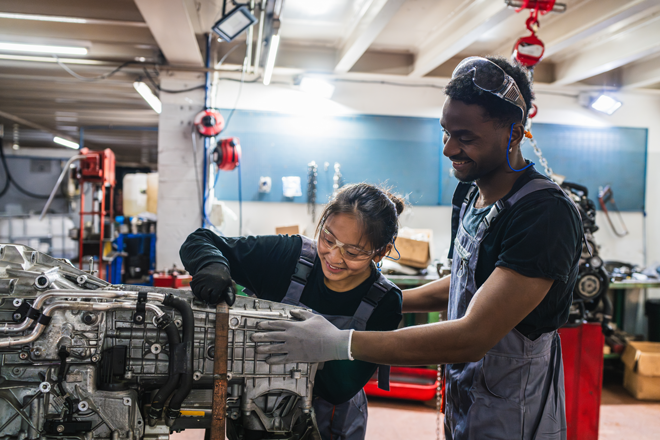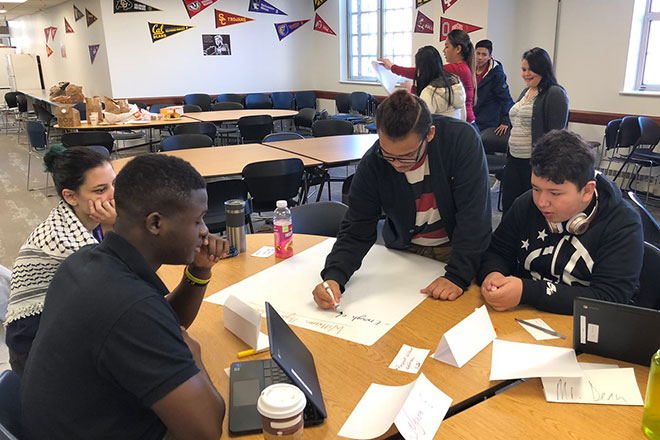SRI is investigating the range of high school career development opportunities in Los Angeles Unified School District (LAUSD). The study will examine how career development opportunities are implemented, who has access to and participates in them, what students’ experiences are, and how participation is associated with students’ progression in school.
Alternative high schools were originally conceived of as a place where students who were not succeeding in a traditional setting could have their academic needs met. These schools have developed negative stigmas, with the reputation as being credit-recovery factories for students who are off-track to graduate.
Including student voice in school design is an important strategy for promoting and facilitating educational equity. Ensuring that all students’ backgrounds and perspectives are considered is especially critical during a time when many people in the United States continue to experience the injustice of racial and social inequities.
This research brief summarizes student outcome findings from SRI International’s evaluation of the California Linked Learning District Initiative, an effort to build robust district-level systems to sustain high school career pathways in nine school districts in the state. With funding from The James Irvine Foundation, SRI conducted a rigorous multimethod evaluation of the initiative over … Continue reading Linked Learning Student Outcomes: Summary of Effects on High School and Early Postsecondary Education
This report from SRI International’s multiyear evaluation of the California Linked Learning District Initiative is the first to include postsecondary outcomes for students in Linked Learning pathways and confirms many of the promising findings from previous years. Compared with similar peers in traditional high school programs, students participating in certified Linked Learning pathways were more … Continue reading Taking Stock of the California Linked Learning District Initiative: Seventh-Year Evaluation Report
This brief describes the successes and challenges the districts have experienced in fostering access and equity in Linked Learning pathways, examining five groups of students frequently underserved by traditional schools: students with low prior achievement, English learners, African-American students, Latino students, and female students. Throughout the evaluation and in this brief, we focus on data … Continue reading Access & Equity in Linked Learning: A Report on Pathway Access and Academic Outcomes for Traditionally Underserved Students
Linked Learning is an approach for transforming high schools to prepare all students for college, career, and life. It works through career-themed pathways that integrate college preparatory academics, rigorous technical training, work-based learning, and supports to help students stay on track. With support from The James Irvine Foundation, SRI International has evaluated this approach at … Continue reading What it Takes to Create Linked Learning: A Report on Lessons Learned from Evaluating the Approach in Practice
The rapidly expanding Linked Learning approach blends career technical and college preparatory course sequence in a single high school pathway, representing the convergence of two strands of high school reform from the past thirty years. Using data from nine California districts, we examine the effect of high school Linked Learning participation on students’ early community … Continue reading Community College On-Track Indicators for Linked Learning Students
SRI examined the impact of a program that combines strong academics with real-world experience. Its goal: help students build a foundation for success in college, careers—and life. In 2009, recognizing the challenges inherent for individual schools or pathways trying to redesign the high school experience, The James Irvine Foundation launched the California Linked Learning District … Continue reading Evaluation of the California Linked Learning District Initiative
This research brief compares the postsecondary outcomes of students in certified Linked Learning pathways with those of peers with similar demographic characteristics and prior achievement in traditional high school programs. Certified pathways are those deemed to have met established quality standards through an external review. We found that Linked Learning students enrolled in college, remained … Continue reading Linked Learning and Postsecondary Transitions: A Report on the Early Postsecondary Education Outcomes of Linked Learning Students



